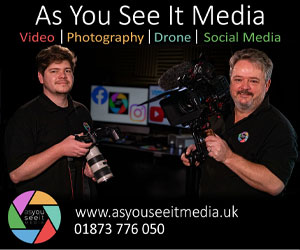Broadcast News
11/12/2015
Big Interview – Bluebell In A Nutshell

Based in the UK, Bluebell Opticom has been designing and manufacturing high-quality fibre optic transmission equipment for the broadcast, telecommunications and satellite industries since 1994. Specialising in 'point to point' fibre technology, today Bluebell has grown into an international organisation, as its Managing Director, Paul McCann, tells BFV...
BFV: Can you give us a brief history of Bluebell?
Paul: Bluebell started life on Blythe Road in Shepherds Bush, London, in 1994, just down the road from BBC Television Centre. In fact, the BBC was our first customer.
We started by developing a range of optical converters for the newly adopted serial digital interface. Sending SDI over standard coax cables didn't work over distances of more than 150 metres, thus opening a gap in the market for a fibre product.
We grew from two people in a basement in London with two products, to a truly international organisation with headquarters in Berkshire and partners in 28 countries. We have a broad spectrum of fibre converter products that have been tuned for ease of use and out-of-the-box operation. We spend a big percentage of revenue on research and design to stay in front of the technology curve. The result is that we can transport just about every signal prevalent in the broadcast arena over fibre cleanly, efficiently, and in a cost-effective package. We have come a long way in 21 years.
Bluebell has a range of products, manufactured to ISO9001 standards. As these standards have been developed and implemented, has this created additional challenges as technology continues to change?
The ISO 9001 standard is a quality assurance stamp and a guideline that controls how we build our equipment. In other words, it's a gauge for repeatability. We have a very rigid set of parameters for our process control. With ISO 9001 as a template, once we set the manufacturing process control, it is fixed through the life cycle of the product. Each piece of equipment of the same type is manufactured in exactly the same way, without deviation, even down to the heat profile of the surface mount reflow oven. Each component on the board has complete traceability back to the foundry where it was made. We even track which smelting plant was used for the gold on the circuit board and which country the tantalum comes from. This diligence allows us to comply with the international "conflict minerals" directive.
We also spend a lot of time on certifying our equipment. Because Bluebell is used all over the world, we keep abreast of safety and EMC compliance requirements globally. All of our equipment is rigorously tested for EMC emissions and immunity, CE certification, FCC compliance, CB safety compliance, EN 61000, EN 55022, Canada's ICES-003, EN 60950-1... The list goes on. This testing is an expensive necessity so that we can sell in every market worldwide – broadcast, satellite, telecommunication, military, sub-sea, medical, and education – and ensure all the boxes are ticked.
As technology advances, and components become smaller and more integrated, the process becomes more complex. For example, when we assemble a new board that uses some of our bigger FPGAs, we X-ray the prototypes to see that we have placed the FPGAs correctly. The process is then committed to our ISO 9001 documentation so that it stays right from then on.
We are very proud that all our equipment is made in the UK. We have resisted the temptation to manufacture our equipment offshore. Sure, it would be cheaper to build, and there would be a cost benefit per unit, but quality would suffer. We would lose the ability to control the very high standard that we have upheld since our beginning.
The company provides application-specific solutions for its customers and their events/projects. What does this entail?
Our application-specific products are a very important part of our overall offering, while our standard product range is the engine that drives Bluebell forward. Our standard products are well-known and used throughout the world, making up about 80 percent of our output. But the application-specific products, or "specials", are a bit more fun to create and require a different approach. We love it when a customer asks us for a device that will perform a specific function or set of functions. Not only do we get to fulfil the customer's requirement, but, if the product seems to have a broader appeal, we make a point of putting it into mass production in order to benefit more people.
One example was a specific requirement from an OB truck company in the U.S. who wanted to connect two talkback systems together using fibre. The difficulty was that the two systems used different control data formats, and sometimes the talkback systems had to be extended using a third system installed in the venue. The customer needed a multiformat data communications system with two discrete duplex audio channels. We were able to go from concept to shipping in a matter of months. The customer now has an open platform that will interoperate with most talkback systems on the market and is very happy with the result. We immediately saw that this unit, the BN623, could be deployed in many applications, so we put in into our product range, and it is selling well.
We also have tailored flypacks, racks, and caddies that can be formatted for any number of signal combinations. The secret is the modularity of our range. Our circuit board dimensions allow us to produce small, lightweight, and portable systems that are unique and durable.
There has been a lot of discussion regarding the transition to IP; has this affected Bluebell in any way?
To help our customers prepare for the future, we have already begun selling our 4K products, and our 8K fibre transport equipment is nearly ready, requiring only final testing. We have also been working on IP technologies for several years now.
To me, IP is one of the fastest-evolving sectors of broadcast technology. We all started with H.264 transport with IEEE 1588 for timing, then quickly moved to SMPTE 2022 in all its guises. Since IBC we have been learning about RFC 4175, a much more sensible and less bandwidth-hungry way of transporting program and control signals. Last month, the Video Services Forum published a draft document called "Transport of Uncompressed Elementary Stream Media over IP" (TR-03), describing how the new format operates. In essence, rather than wrapping up video, audio, and data in SDI using SMPTE embedding techniques and hiding the data in the vertical and horizontal blanking, the raw elements – video data, audio data, and data data – are decoded from the SDI transport stream and transported separately on individual ports on a network. We see potential in RFC 4175 and are exploring the benefits of incorporating such technology into our fibre transport products at some point.
Bluebell is one of the founding members of IPPG, an organisation set up to create a working ecosystem for IP-type broadcast products to ensure interoperability among equipment. IPPG also wants to ensure ease of operation wherein the technology is intelligent enough to work out what it is, what it should be connected to, and how. One of the biggest downsides of this IP age in broadcast is the setup time. Broadcasters traditionally like a plug-and-play kit. If IP devices require setting IP and MAC addresses, subnet masks, and the like, then people will shy away from using them.
I see a very exciting, diverse future in our industry, with all sorts of interesting engineering challenges. The medium and content will remain the same, but the format and protocols will evolve. And there will always be a need for fibre technology.
www.bluebellcomms.co.uk
This article is also available to read at BFV online.
BFV: Can you give us a brief history of Bluebell?
Paul: Bluebell started life on Blythe Road in Shepherds Bush, London, in 1994, just down the road from BBC Television Centre. In fact, the BBC was our first customer.
We started by developing a range of optical converters for the newly adopted serial digital interface. Sending SDI over standard coax cables didn't work over distances of more than 150 metres, thus opening a gap in the market for a fibre product.
We grew from two people in a basement in London with two products, to a truly international organisation with headquarters in Berkshire and partners in 28 countries. We have a broad spectrum of fibre converter products that have been tuned for ease of use and out-of-the-box operation. We spend a big percentage of revenue on research and design to stay in front of the technology curve. The result is that we can transport just about every signal prevalent in the broadcast arena over fibre cleanly, efficiently, and in a cost-effective package. We have come a long way in 21 years.
Bluebell has a range of products, manufactured to ISO9001 standards. As these standards have been developed and implemented, has this created additional challenges as technology continues to change?
The ISO 9001 standard is a quality assurance stamp and a guideline that controls how we build our equipment. In other words, it's a gauge for repeatability. We have a very rigid set of parameters for our process control. With ISO 9001 as a template, once we set the manufacturing process control, it is fixed through the life cycle of the product. Each piece of equipment of the same type is manufactured in exactly the same way, without deviation, even down to the heat profile of the surface mount reflow oven. Each component on the board has complete traceability back to the foundry where it was made. We even track which smelting plant was used for the gold on the circuit board and which country the tantalum comes from. This diligence allows us to comply with the international "conflict minerals" directive.
We also spend a lot of time on certifying our equipment. Because Bluebell is used all over the world, we keep abreast of safety and EMC compliance requirements globally. All of our equipment is rigorously tested for EMC emissions and immunity, CE certification, FCC compliance, CB safety compliance, EN 61000, EN 55022, Canada's ICES-003, EN 60950-1... The list goes on. This testing is an expensive necessity so that we can sell in every market worldwide – broadcast, satellite, telecommunication, military, sub-sea, medical, and education – and ensure all the boxes are ticked.
As technology advances, and components become smaller and more integrated, the process becomes more complex. For example, when we assemble a new board that uses some of our bigger FPGAs, we X-ray the prototypes to see that we have placed the FPGAs correctly. The process is then committed to our ISO 9001 documentation so that it stays right from then on.
We are very proud that all our equipment is made in the UK. We have resisted the temptation to manufacture our equipment offshore. Sure, it would be cheaper to build, and there would be a cost benefit per unit, but quality would suffer. We would lose the ability to control the very high standard that we have upheld since our beginning.
The company provides application-specific solutions for its customers and their events/projects. What does this entail?
Our application-specific products are a very important part of our overall offering, while our standard product range is the engine that drives Bluebell forward. Our standard products are well-known and used throughout the world, making up about 80 percent of our output. But the application-specific products, or "specials", are a bit more fun to create and require a different approach. We love it when a customer asks us for a device that will perform a specific function or set of functions. Not only do we get to fulfil the customer's requirement, but, if the product seems to have a broader appeal, we make a point of putting it into mass production in order to benefit more people.
One example was a specific requirement from an OB truck company in the U.S. who wanted to connect two talkback systems together using fibre. The difficulty was that the two systems used different control data formats, and sometimes the talkback systems had to be extended using a third system installed in the venue. The customer needed a multiformat data communications system with two discrete duplex audio channels. We were able to go from concept to shipping in a matter of months. The customer now has an open platform that will interoperate with most talkback systems on the market and is very happy with the result. We immediately saw that this unit, the BN623, could be deployed in many applications, so we put in into our product range, and it is selling well.
We also have tailored flypacks, racks, and caddies that can be formatted for any number of signal combinations. The secret is the modularity of our range. Our circuit board dimensions allow us to produce small, lightweight, and portable systems that are unique and durable.
There has been a lot of discussion regarding the transition to IP; has this affected Bluebell in any way?
To help our customers prepare for the future, we have already begun selling our 4K products, and our 8K fibre transport equipment is nearly ready, requiring only final testing. We have also been working on IP technologies for several years now.
To me, IP is one of the fastest-evolving sectors of broadcast technology. We all started with H.264 transport with IEEE 1588 for timing, then quickly moved to SMPTE 2022 in all its guises. Since IBC we have been learning about RFC 4175, a much more sensible and less bandwidth-hungry way of transporting program and control signals. Last month, the Video Services Forum published a draft document called "Transport of Uncompressed Elementary Stream Media over IP" (TR-03), describing how the new format operates. In essence, rather than wrapping up video, audio, and data in SDI using SMPTE embedding techniques and hiding the data in the vertical and horizontal blanking, the raw elements – video data, audio data, and data data – are decoded from the SDI transport stream and transported separately on individual ports on a network. We see potential in RFC 4175 and are exploring the benefits of incorporating such technology into our fibre transport products at some point.
Bluebell is one of the founding members of IPPG, an organisation set up to create a working ecosystem for IP-type broadcast products to ensure interoperability among equipment. IPPG also wants to ensure ease of operation wherein the technology is intelligent enough to work out what it is, what it should be connected to, and how. One of the biggest downsides of this IP age in broadcast is the setup time. Broadcasters traditionally like a plug-and-play kit. If IP devices require setting IP and MAC addresses, subnet masks, and the like, then people will shy away from using them.
I see a very exciting, diverse future in our industry, with all sorts of interesting engineering challenges. The medium and content will remain the same, but the format and protocols will evolve. And there will always be a need for fibre technology.
www.bluebellcomms.co.uk
This article is also available to read at BFV online.
Top Related Stories
Click here for the latest broadcast news stories.
10/07/2023
Brompton Technology Helps Cyans LED Virtual Studio Transform Taiwan'sTV And Film Production Industry
Harvatek, a Taiwanese supplier of LEDs, has partnered with an experienced local equipment distributor to establish a joint subsidiary called Cyans Vis
Brompton Technology Helps Cyans LED Virtual Studio Transform Taiwan'sTV And Film Production Industry
Harvatek, a Taiwanese supplier of LEDs, has partnered with an experienced local equipment distributor to establish a joint subsidiary called Cyans Vis
30/06/2023
Cobalt Iron Patents Proactive Technology
Cobalt Iron Inc. has announced that it has received a patent on its proactive technology for automated remediation of cyber and storage events. U.S. P
Cobalt Iron Patents Proactive Technology
Cobalt Iron Inc. has announced that it has received a patent on its proactive technology for automated remediation of cyber and storage events. U.S. P
23/06/2023
d&b audiotechnik Announces Technology Integration Partnership With SSL
d&b audiotechnik has announced a technology integration partnership with Solid State Logic (SSL) to integrate the d&b Soundscape immersive sound syste
d&b audiotechnik Announces Technology Integration Partnership With SSL
d&b audiotechnik has announced a technology integration partnership with Solid State Logic (SSL) to integrate the d&b Soundscape immersive sound syste
23/06/2023
OSA International Appoints Technology Specialist
OSA International has hired Tim Wiley to join the company as Technology Specialist. With over two decades of experience in the broadcast and AV sector
OSA International Appoints Technology Specialist
OSA International has hired Tim Wiley to join the company as Technology Specialist. With over two decades of experience in the broadcast and AV sector
23/03/2018
Bluebell Opticom 2018 NAB Show Preview
At the 2018 NAB Show, Bluebell will demonstrate the Silhouette line of rugged, deployable, high-density, mixed-technology media converters. The heart
Bluebell Opticom 2018 NAB Show Preview
At the 2018 NAB Show, Bluebell will demonstrate the Silhouette line of rugged, deployable, high-density, mixed-technology media converters. The heart
22/03/2018
Bluebell Opticom At NAB 2018
Bluebell has announced that it will demonstrate the Silhouette line of rugged, deployable, high-density, mixed-technology media converters at the 2018
Bluebell Opticom At NAB 2018
Bluebell has announced that it will demonstrate the Silhouette line of rugged, deployable, high-density, mixed-technology media converters at the 2018
23/11/2023
Brompton Technology Strengthens Its Leadership Team
Brompton Technology is strengthening its leadership team by promoting Joanna Muggeridge to Director of Marketing and Lotta Schiefer to Director of Sal
Brompton Technology Strengthens Its Leadership Team
Brompton Technology is strengthening its leadership team by promoting Joanna Muggeridge to Director of Marketing and Lotta Schiefer to Director of Sal
23/11/2023
Bouygues Telecom Deploys Broadpeak's nanoCDN™ multicast ABR Technology
Broadpeak® has announced that Bouygues Telecom, a global communications operator in France, has deployed Broadpeak's nanoCDN™ multicast ABR technology
Bouygues Telecom Deploys Broadpeak's nanoCDN™ multicast ABR Technology
Broadpeak® has announced that Bouygues Telecom, a global communications operator in France, has deployed Broadpeak's nanoCDN™ multicast ABR technology
20/11/2023
FC Barcelona And Supponor Launch First-Ever Use Of Virtual Technology
Supponor has announced that Spanish La Liga F El Clásico will mark the first-ever use of virtual technology in a women's football match. This groundbr
FC Barcelona And Supponor Launch First-Ever Use Of Virtual Technology
Supponor has announced that Spanish La Liga F El Clásico will mark the first-ever use of virtual technology in a women's football match. This groundbr
14/11/2023
The Crew And Clear-Com: Modern Broadcasting With Latest Technology
Clear-Com and The Crew BV come together to bring the latest OB van technology to take on their variety of programs and set locations. Based in Nederho
The Crew And Clear-Com: Modern Broadcasting With Latest Technology
Clear-Com and The Crew BV come together to bring the latest OB van technology to take on their variety of programs and set locations. Based in Nederho
14/11/2023
Brompton Technology Processing Delivers For Argo Visual
Argo Visual, a multimedia equipment rental company based in Jakarta, Indonesia, is a long-time user of Brompton Technology LED processing. Since its i
Brompton Technology Processing Delivers For Argo Visual
Argo Visual, a multimedia equipment rental company based in Jakarta, Indonesia, is a long-time user of Brompton Technology LED processing. Since its i
10/11/2023
Facilis Technology Partners With Broadfield Distributing
Facilis Technology has announced a strategic partnership with Broadfield Distributing, Inc. to extend the distribution of their products across North
Facilis Technology Partners With Broadfield Distributing
Facilis Technology has announced a strategic partnership with Broadfield Distributing, Inc. to extend the distribution of their products across North
10/11/2023
Brompton Technology Celebrates Remarkable Year
Brompton Technology has celebrated a remarkable year marked by an array of significant commercial achievements and groundbreaking innovations. Last Fr
Brompton Technology Celebrates Remarkable Year
Brompton Technology has celebrated a remarkable year marked by an array of significant commercial achievements and groundbreaking innovations. Last Fr
06/11/2023
ENCO Joins The Ryan Seacrest Foundation's Technology Partner Community
ENCO is among the latest vendors to join the Ryan Seacrest Foundation's technology partner community, helping the foundation establish a simplified me
ENCO Joins The Ryan Seacrest Foundation's Technology Partner Community
ENCO is among the latest vendors to join the Ryan Seacrest Foundation's technology partner community, helping the foundation establish a simplified me
25/10/2023
Brompton Technology Powers Nikon Creates' New Heiwajima Stage In Tokyo
Nikon Creates Studio, a new subsidiary of Nikon Corporation, has recently unveiled its new HEIWAJIMA STAGE, a multifunctional shooting facility create
Brompton Technology Powers Nikon Creates' New Heiwajima Stage In Tokyo
Nikon Creates Studio, a new subsidiary of Nikon Corporation, has recently unveiled its new HEIWAJIMA STAGE, a multifunctional shooting facility create















